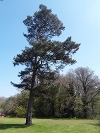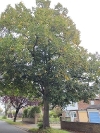Replacement of Racecourse Road (Stroud Green) poplar trees
Help us choose the replacement trees.
Consultation status ArchivedActivity closed. Results published.
Why we have to remove the trees
The 56 large mature Lombardy poplars on Stroud Green were planted around 1967, making the trees nearly 60 years old, which is much older than their expected lifespan.
Map of the area:

Lombardy poplars (Populus nigra 'Italica') are a rapidly growing, but short-lived tree, which can reach 40-50 meters in height. They have a distinctly columnar shape and are often planted as windbreaks or privacy screens. Their typical lifespan is between 30-50 years; however, they are susceptible to stem canker disease and shed their branches quite easily.
Three of the trees on Racecourse Road have fallen in the last three years, one across Racecourse Road and two onto the Green. Following a detailed inspection of the trees in 2023, we found that most of them had some level of decline and hollowing, and six of them urgently needed to be felled, which was carried out in January 2024. We're now at the point where we need to fell the remaining 50 trees to keep the public safe.
 |  |
What the replacement plan is
We're planning to replace the felled trees between November 2025 and February 2026, as this will give us the time to source the chosen trees and plant them at a suitable time of the year.
Approximately 20 years ago, we planted two rows of London plane trees on the park sides of Racecourse Road and we currently have 46 of these trees remaining, which range from 6 to 10 metres tall. These trees are slow growing, will reach a height of 35 metres, and live for several hundred years. They are valued for their ability to adapt to urban conditions and resistance to pollution, and are therefore widely planted as a street tree in large cities.
The London plane trees will eventually be the dominant trees, but while they are getting bigger, we want to plant a line of smaller, faster-growing trees alongside them, to provide interest, colour and more space for wildlife.
The health of these new young trees will be monitored and maintained by our Countryside Service and if they fail to thrive, we'll replace them to ensure the continuity of the avenue.
Why we need your help
It's important that we understand what local people would prefer, and we'd like you to rank, in order of preference, the following type of trees you'd like to see planted alongside the London plane trees:
 1. Same species as has been felled i.e. Lombardy poplar |  2. Similar upright form to the Lombardy poplar, but a different tree e.g. Black pine or Cypress oak |  3.More rounded form in comparison to the Lombardy poplar e.g. small-leaved lime |
Certain species of trees are not suitable for the site due to the soil type and the amount of sun/shade, e.g. Acers. However, we're open to your suggestions.
How to take part
Our survey closed at midnight on Sunday, 1 September 2024.
If you have any questions about the survey, please email trees@westberks.gov.uk
For general enquiries about Parks and Countryside, please visit our webpage.
What happens next
All feedback we receive will be considered, analysed, and used to help us decide which type of tree to use in the replacement scheme. A final decision will be made by officers in October 2024.
The new heavy standard trees will be sourced in time for the November 2025 to February 2026 planting season.
If you'd like to keep up to date with how we're doing, please subscribe to our free Environment e-newsletter.
What you told us
What we did
This species of tree has dominated the skyline of that part of Newbury since they became fully grown and many residents consider the avenue to be iconic. It would be difficult to achieve the same impact with another native tree species. The fast-growing nature of the species has its disadvantages, as they're relatively short-lived, however, this also means that a visible, tall avenue of trees can be achieved in a relatively short time.
Ecologically, they are not the best available but later in the tree’s life the occluded bark (bark which in-grows) provides a home for bats, and we already know from the consultation that these trees are a roosting site for populations of starlings and other birds.
Poplars draw up large amounts of water from the ground and release it into the atmosphere, adding humidity to the air, which has a cooling effect, and makes the air more breathable during heatwaves, and helping with flood alleviation during the wetter months. Due to their upright nature, the species works well as a windbreak and can withstand storms well.
Lombardy Poplars generally require very little maintenance as they do not have large sprawling branches which interfere with passing traffic, nor low growing branches which may need to be lifted above head height to accommodate pedestrians.
As all the existing Poplars are considered to be dangerous and so present a risk to the public, felling will begin from 4 November 2024, and we are aiming to re-plant between November 2025 and February 2026. We won't be inviting the public to take part in planting these trees this time, as the replacement trees are likely to be ‘heavy standards’ (about 14cm in girth and 3.5-4m high) and require specialist equipment to put them into place.




